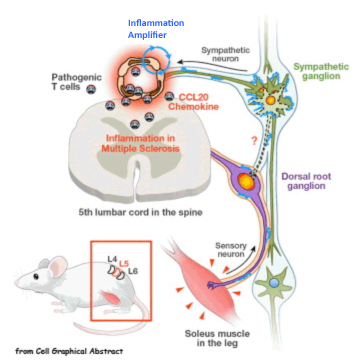ADDRESSJST-CREST 2-2, Yamada-oka Suita, Osaka 565-0871, Japan TEL:81-6-6879-3880 Masaaki Murakami D.V.M. Ph.D. |
AchievementsRegional neural activation defines a gateway for autoreactive T cells to cross the blood-brain barrierAlthough it is believed that neural activations can affect immune responses, very little is known about the neuro-immune interactions involved, especially the key regulators for immune signals to reach from the blood to the CNS. We here describe dorsal blood vessels in the 5th lumbar-cord that show excess chemokine levels in a manner dependent on regional neural activations of the soleus-muscle. These responses appear to act as a gate for blood cell populations including immune cells to enter the CNS. This gate can promote pathogenic T cells inflammatory inflow, which risks autoimmune diseases like multiple sclerosis. Therefore, these regional neuro-immune interactions may offer new therapeutic targets for neurological diseases. Arima Y., M. Harada, D. Kamimura, J-H. Park, F. Kawano, F. E. Yull, T. Kawamoto, Y. Iwakura, U.A.K. Betz, G. Márquez, T. S. Blackwell, Y. Ohira, T. Hirano, and M. Murakami.
Schematic figure of neural activation-induced pathogenic T cell accumulation in the CNS. Neural activation-mediated "Inflammation amplifier" enhancement in endothelial cells of dorsal blood vessels in the 5th lumbar cord induces CCL20 followed by the accumulation of pathogenic Th17 cells, a critical event for the development of EAE.
|
|
Copyright © 2007 Osaka University all rights reserved.
|
|
